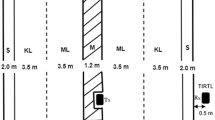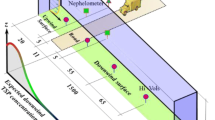Abstract
During July 2016, an on-road study was conducted in and around the Toronto, Canada region to investigate the spatial variation of vehicle-induced turbulence on highways. The power spectral density of turbulent kinetic energy (TKE) while following on-road vehicles is significantly enhanced for frequencies greater than 0.5 Hz. This increase is not present while driving isolated from traffic, demonstrating that TKE is enhanced considerably on highways in the presence of vehicles. The magnitude of normalized TKE is found to decay following a power-law relationship with increasing normalized distance behind on-road vehicles, which is most pronounced behind heavy-duty trucks. The results suggest that the TKE in the vehicle wake is maximized in the upper shear layer near the vehicle top. An extended parametrization is outlined that describes the total on-road TKE enhancement due to a composition of vehicles, which includes a vertical dependence on the magnitude of TKE.










Similar content being viewed by others
References
Alonso-Estébanez A, Pascual-Muñoz P, Yagüe C, Laina R, Castro-Fresno D (2012) Field experimental study of traffic-induced turbulence on highways. Atmos Environ 61:189–196
Baker C (2001) Flow and dispersion in ground vehicle wakes. J Fluid Struct 15(7):1031–1060
Bäumer D, Vogel B, Fiedler F (2005) A new parameterisation of motorway-induced turbulence and its application in a numerical model. Atmos Environ 39(31):5750–5759
Belušić D, Lenschow DH, Tapper NJ (2014) Performance of a mobile car platform for mean wind and turbulence measurements. Atmos Meas Tech 7(1):949–978
Bhautmage U, Gokhale S (2016) Effects of moving-vehicle wakes on pollutant dispersion inside a highway road tunnel. Environ Pollut 218:783–793
Carpentieri M, Kumar P, Robins A (2012) Wind tunnel measurements for dispersion modelling of vehicle wakes. Atmos Environ 62:9-2
Chock DP (1980) General motors sulfate dispersion experiment. Boundary-Layer Meteorol 18(4):431–451
EMOS (2016) Environmental Meteorological Observation Station (EMOS), Department of Earth and Space Science and Engineering, York University. http://www.yorku.ca/pat/weatherStation/index.php
Eskridge RE, Hunt JC (1979) Highway modeling. Part I: prediction of velocity and turbulence fields in the wake of vehicles. J Appl Meteorol Climatol 18(4):387–400
Eskridge RE, Thompson RS (1982) Experimental and theoretical study of the wake of a block-shaped vehicle in a shear-free boundary flow. Atmos Environ 16(12):2821–2836
Gordon M, Staebler RM, Liggio J, Makar P, Li S, Wentzell J, Lu G, Lee P, Brook JR (2012) Measurements of enhanced turbulent mixing near highways. J Appl Meteorol Climatol 51(9):1618–1632
Hoek G, Krishnan RM, Beelen R, Peters A, Ostro B, Brunekreef B, Kaufman JD (2013) Long-term air pollution exposure and cardio-respiratory mortality: a review. Environ Health 12(1):43
Hosker RP Jr, Rao KS, Gunter RL, Nappo CJ, Meyers TP, Birdwell KR, White JR (2003) Issues affecting dispersion near highways: Light winds, intra-urban dispersion, vehicle wakes, and the ROADWAY-2 Dispersion Model. NOAA Tech. Memo. OAR ARL-247. http://www.arl.noaa.gov/documents/reports/arl-247.pdf
Huang L, Gong SL, Gordon M, Liggio J, Staebler R, Stroud CA, Lu G, Mihele C, Brook JR, Jia CQ (2014) Aerosol–computational fluid dynamics modeling of ultrafine and black carbon particle emission, dilution, and growth near roadways. Atmos Chem Phys 14(23):12631–12648
Kaimal JC, Finnigan JJ (1994) Atmospheric boundary layer flows—their structure and measurement. Oxford University Press, New York
Kalthoff N, Bäumer D, Corsmeier U, Kohler M, Vogel B (2005) Vehicle-induced turbulence near a motorway. Atmos Environ 39(31):5737–5749
Kastner-Klein PK, Berkowicz R, Plate E (2000) Modelling of vehicle-induced turbulence in air pollution studies for streets. Int J Environ Pollut 14:496–507
Kim Y, Huang L, Gong S, Jia CQ (2016) A new approach to quantifying vehicle induced turbulence for complex traffic scenarios. Chin J Chem Eng 24(1):71–78
Lee J, Choi H (2009) Large eddy simulation of flow over a three-dimensional model vehicle. Sixth international symposium on turbulence and shear flow phenomena, June 22–24 2009, Seoul, South Korea
Lo KH, Kontis K (2017) Flow around an articulated lorry model. Exp Therm Fluid Sci 82:58–74
Makar PA, Zhang J, Gong W, Stroud C, Sills D, Hayden KL, Brook J, Levy I, Mihele C, Moran MD, Tarasick DW, He H, Plummer J (2010) Mass tracking for chemical analysis the causes of ozone formation in southern Ontario during BAQS-Met 2007. Atmos Chem Phys 10(22):11151–11173
McArthur D, Burton D, Thompson M, Sheridan J (2016) On the near wake of a simplified heavy vehicle. J Fluid Struct 66:293–314
Mejia ODL, Gómez SAA, Otero DEB, Camargo LEM (2016) Analysis of the vorticity in the near wake of a station wagon. J Fluid Eng 139(2):021105
Mohan M, Siddiqui TA (1998) Analysis of various schemes for the estimation of atmospheric stability classification. Atmos Environ 32(21):3775–3781
MTO (2016) Provincial highways: Traffic volumes—King’s highways/secondary highways/tertiary roads: 1988–2016. Ministry of Transportation, Highway Standards Branch, Traffic Office
Rao ST, Sedefian L, Czapski UH (1979) Characteristics of turbulence and dispersion of pollutants near major highways. J Appl Meteorol Climatol 18(3):283–293
Rao K, Gunter R, White J, Hosker R (2002) Turbulence and dispersion modeling near highways. Atmos Environ 36(27):4337–4346
Sterken L, Sebben S, Löfdahl L (2016) Numerical implementation of detached-eddy simulation on a passenger vehicle and some experimental correlation. J Fluid Eng 138(9):091105
Wang YJ, Zhang KM (2009) Modeling near-road air quality using a computational fluid dynamics model, CFD-VIT-RIT. Environ Sci Technol 43(20):7778–7783
Wang YJ, Zhang KM (2012) Coupled turbulence and aerosol dynamics modeling of vehicle exhaust plumes using the CTAG model. Atmos Environ 59:284–293
Wang YJ, Denbleyker A, Mcdonald-Buller E, Allen D, Zhang KM (2011) Modeling the chemical evolution of nitrogen oxides near roadways. Atmos Environ 45(1):43–52
Wang JY, Yang CH, Hu XJ, Guo B (2013) Aerodynamic optimization of a simplified SUV. In: Fourth international conference on digital manufacturing and automation, June 29–30 2013, Qindao, Shandong, China
Wilczak JM, Oncley SP, Stage SA (2001) Sonic anemometer tilt correction algorithms. Boundary-Layer Meteorol 99(1):127–150
Acknowledgements
We would like to thank the three anonymous reviewers for their insightful and valuable comments. We thank Sepehr Fathi and Zheng Qi Wang for assisting with the measurement acquisition (as drivers in this experiment) and Brandon Loy for his assistance during the assembly process of the mobile laboratory. Funding support for Stefan J. Miller was provided by the Natural Science and Engineering Research Council of Canada (NSERC) Collaborative Research and Training Experience (CREATE) program in collaboration with the Integrating Atmospheric Chemistry and Physics from Earth to Space (IACPES) program.
Author information
Authors and Affiliations
Corresponding author
Appendices
Appendix 1: Following Distance Calculation
Figure 11 Displays the pixel geometry and Fig. 12 shows the physical geometry. In Fig. 11, \( P_{H} \) is the pixel distance between the attachment points on the hood of the sport-utility vehicle, (corresponding to the physical distance \( Y_{H} \) in Fig. 12) and \( P_{r} \) is the pixel width of the road (corresponding to the physical road width \( Y_{r} \) in Fig. 12). Noting that the ratio between \( P_{H} \) and the image width \( W \) (Fig. 11) is equal to the ratio between \( Y_{H} \) and the width of the field of view at this location, \( Y_{W,H} \) (Fig. 12) gives
The basic geometry. Refer to Fig. 3 which displays the measured physical geometry (i.e. \( X_{h} \) and \( Y_{H} \))
Likewise, the ratio between \( P_{r} \) (at the location of the vehicle’s shadow) and the image width \( W \) (Fig. 11) is equal to the ratio between road width \( Y_{r} \) and the width of the field of view at this location \( Y_{W,r} \) (Fig. 12),
From Fig. 12, similar triangles give
where \( x_{m} \) is the following distance and \( X_{H} \) is the measured distance between the dashcam and the attachment points at the front of the vehicle (see Fig. 3). Using Eq. 9 and Eq. 10 in Eq. 11 yields
Noting that the highway intersects the image frame at X (see Fig. 11) which is also equal to image frame width, W, then
where \( H_{s} \) is the pixel difference between the vanishing point \( H_{v} \) and the target distance \( H_{f} + H_{H} \) (at location \( P_{r} \)) and Q is the distance in pixels between W (denoted \( W/2 \) in Fig. 11) and the vanishing point.
Substituting Eq. 13 into Eq. 12 gives
If we assume that the calculated vanishing point is centred about W, then
and the following distance in physical units can be expressed as
Since \( H_{s} = H_{v} - H_{f} - H_{H} \), \( x_{m} \) can be written as
Finally, since \( x_{m} \) is defined as the distance between the measurement location (i.e. the sonic anemometer) and the back-end of the target vehicle (i.e. its shadow), the measured distance between the dashcam and the anemometer (≈ \( X_{H} \)) needs to be removed from Eq. 16b, giving
In Eq. 17, \( Y_{r} \) is estimated from a Google Earth satellite image. Since the terrain was generally flat and the dashcam was adhered to the windshield, a single calibration image is used to determine the pixel values of \( H_{v} \), \( H_{H} \), \( P_{H} \) and \( \beta \). Physically, \( H_{H} \) includes the distance between the dashcam and the vehicle’s front end, and some of the highway surface immediately in front of the vehicle (it cannot be seen by the dashcam). Therefore, \( H_{H} \) places a lower limit on the domain of \( x_{m} \). To determine the target distance \( H_{f} \), automated software was developed to locate the step change in greyscale values between the sunlit highway surface and the shadow behind the vehicle. It should be noted that Eq. 17 approaches infinite distance near the horizon (i.e. as \( H_{f} + H_{H} \to H_{v} \)), and therefore a small error in the pixel location near the horizon results in a large error in the following distance. Consequently, the measurement domain is limited to a maximum following distance of 100 m to limit error related to image resolution (except Sect. 5). Equation 17 was tested in a parking lot using distances measured up to 70 m. The results determined from Eq. 17 were generally within ± 1 m of the measured distances.
Appendix 2: Near-Road Spectral Details
See Table 5.
Appendix 3: On-Road Spectral Details
See Table 6.
Rights and permissions
About this article
Cite this article
Miller, S.J., Gordon, M., Staebler, R.M. et al. A Study of the Spatial Variation of Vehicle-Induced Turbulence on Highways Using Measurements from a Mobile Platform. Boundary-Layer Meteorol 171, 1–29 (2019). https://doi.org/10.1007/s10546-018-0416-9
Received:
Accepted:
Published:
Issue Date:
DOI: https://doi.org/10.1007/s10546-018-0416-9






